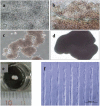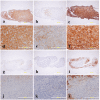Synthesis of photo-reactive poly (vinyl alcohol) and construction of scaffold-free cartilage like pellets in vitro
- PMID: 29942648
- PMCID: PMC6007571
- DOI: 10.1093/rb/rby009
Synthesis of photo-reactive poly (vinyl alcohol) and construction of scaffold-free cartilage like pellets in vitro
Abstract
Photo-reactive poly(vinyl alcohol) (PRPVA) was synthesized by introduction of phenyl azido groups into poly(vinyl alcohol) (PVA) and applied for surface modification. PRPVA was grafted onto cell culture plate surface homogeneously or in a micropattern. Human mesenchymal stem cells (hMSCs) cultured on cell culture plate surface and PVA-modified surface showed different behaviors. Cells adhered and spread well on cell culture plate surface, while they did not adhere on PVA-grafted surface at all. When hMSCs were cultured on PVA-micropatterned surface, they formed a cell micropattern. Cells formed pellets after cultured on PVA homogeneously modified surface in chondrogenic induction medium for 2 weeks. The pellets were positively stained by hematoxylin/eosin, safranin-O/fast green and toluidin blue, and they were also stained brown by Type II collagen and proteoglycan immunohistological staining. Real-time PCR analysis was conducted to investigate the expression of colI, colII, colX, aggrecan and sox9 mRNA. Results of gene expression were in agreement with those of histological and immunohistological observations. These results indicated that hMSCs cultured on PVA-modified surface performed chondrogenic differentiation, and it was possible to construct scaffold-free cartilage like pellets with PVA-modified surface in vitro.
Keywords: chondrogenic differentiation; photo-reactive poly (vinyl alcohol); surface modification.
Figures






Similar articles
-
Chondrogenic differentiation of human mesenchymal stem cells on photoreactive polymer-modified surfaces.Biomaterials. 2008 Jan;29(1):23-32. doi: 10.1016/j.biomaterials.2007.08.043. Biomaterials. 2008. PMID: 17935777
-
Repair of osteochondral defects with a construct of mesenchymal stem cells and a polydioxanone/poly(vinyl alcohol) scaffold.Biotechnol Appl Biochem. 2008 Feb;49(Pt 2):155-64. doi: 10.1042/BA20070149. Biotechnol Appl Biochem. 2008. PMID: 17919122
-
Membrane-based cultures generate scaffold-free neocartilage in vitro: influence of growth factors.Tissue Eng Part A. 2010 Feb;16(2):513-21. doi: 10.1089/ten.TEA.2009.0326. Tissue Eng Part A. 2010. PMID: 19715388
-
[Experiment of bone morphogenetic protein 2 induced chondrogenic differentiation of human Achilles tendon-derived stem cells in vitro].Zhongguo Xiu Fu Chong Jian Wai Ke Za Zhi. 2013 Dec;27(12):1492-8. Zhongguo Xiu Fu Chong Jian Wai Ke Za Zhi. 2013. PMID: 24640373 Chinese.
-
Cord blood cell-derived iPSCs as a new candidate for chondrogenic differentiation and cartilage regeneration.Stem Cell Res Ther. 2017 Jan 28;8(1):16. doi: 10.1186/s13287-017-0477-6. Stem Cell Res Ther. 2017. PMID: 28129782 Free PMC article.
Cited by
-
Highlights on Advancing Frontiers in Tissue Engineering.Tissue Eng Part B Rev. 2022 Jun;28(3):633-664. doi: 10.1089/ten.TEB.2021.0012. Epub 2021 Oct 25. Tissue Eng Part B Rev. 2022. PMID: 34210148 Free PMC article. Review.
-
Scaffolds of Macroporous Tannin Spray With Human-Induced Pluripotent Stem Cells.Front Bioeng Biotechnol. 2020 Oct 15;8:951. doi: 10.3389/fbioe.2020.00951. eCollection 2020. Front Bioeng Biotechnol. 2020. PMID: 33178667 Free PMC article.
-
Advanced hydrogels for the repair of cartilage defects and regeneration.Bioact Mater. 2020 Oct 10;6(4):998-1011. doi: 10.1016/j.bioactmat.2020.09.030. eCollection 2021 Apr. Bioact Mater. 2020. PMID: 33102942 Free PMC article. Review.
-
The in vivo chondrogenesis of cartilage stem/progenitor cells from auricular cartilage and the perichondrium.Am J Transl Res. 2019 May 15;11(5):2855-2865. eCollection 2019. Am J Transl Res. 2019. PMID: 31217859 Free PMC article.
References
-
- Pittenger MF, Mackay AM, Beck SC. et al. Multilineage potential of adult human mesenchymal stem cells. Science 1999;284:143–7. - PubMed
-
- Caplan AI, Bruder SP.. Mesenchymal stem cells: building blocks for molecular medicine in the 21st century. Trends Mol Med 2001;7:259–64. - PubMed
-
- Gonzalez-Fernandez T, Tierney EG, Cunniffe GM. et al. Gene delivery of TGF-beta3 and BMP2 in an MSC-laden alginate hydrogel for articular cartilage and endochondral bone tissue engineering. Tissue Eng A 2016;22:776–87. - PubMed
LinkOut - more resources
Full Text Sources
Other Literature Sources
Research Materials
Miscellaneous

